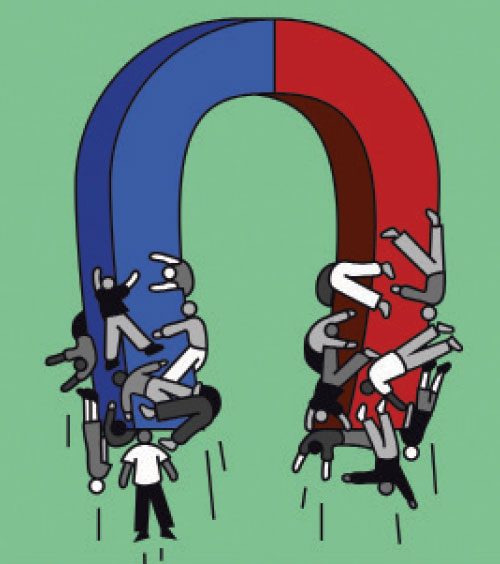 It seems like the world is stuck. Entrenched. Frozen in fear, partisanship, anger, war, frustration, hate, high interest rates, stubborn inflation, distrust, and a host of unknowns about what’s happened, what’s happening, and, most of all, what might happen next. Presidential election years are notoriously fraught with gridlock as the nation awaits an outcome before making any major decisions. A new administration would mean a new sheriff in town, one who thinks he has a mandate to bring about change. In the meantime, we stand pat. We fret. We dig our heels in. We stew. We debate. We suffer from over-analysis paralysis.
It seems like the world is stuck. Entrenched. Frozen in fear, partisanship, anger, war, frustration, hate, high interest rates, stubborn inflation, distrust, and a host of unknowns about what’s happened, what’s happening, and, most of all, what might happen next. Presidential election years are notoriously fraught with gridlock as the nation awaits an outcome before making any major decisions. A new administration would mean a new sheriff in town, one who thinks he has a mandate to bring about change. In the meantime, we stand pat. We fret. We dig our heels in. We stew. We debate. We suffer from over-analysis paralysis.
But I would argue that the general worldwide inertia dates to the onset of the Covid pandemic. That’s when the world as we knew it stopped, and it’s been struggling to get moving ever since. It’s a form of Long Covid, with symptoms that include fatigue, brain fog, heart palpitations, and dizziness. That seems like an apt diagnosis of the state of the world right now, doesn’t it?
Our industry’s collective sluggishness over the past four years is a perfect example. The unparalleled supply chain disruption that followed the pandemic put the brakes on a lot of commerce, but the malaise goes way beyond that. Innovation and risk-taking have largely been backburnered in this period of uncertainty. Granted, companies have been simply trying to survive amid the chaos. The result, unfortunately, is same ol’, same ol’ product. Retailers have played a big role in perpetuating the sameness epidemic, too. Few have been willing to take risks in their buys, especially when millions of Americans switched on the remote, changing where they live, how they work, and what they wear. Buyers are meant to be curators and tastemakers, but they are not clairvoyant. The shock scared them safe.
The sneaker’s rise to ubiquitous fashion statement for all ages and occasions has also played a role in the ongoing lack of product evolution and diversity. Even within that segment, it’s been far more about milking classics than introducing breakthrough technologies. For example, two recent popular styles, Nike’s Air Force 1 and Adidas’ Samba, debuted in 1982 and 1949, respectively. No disrespect. Both are legendary designs. But they’re not exactly new. Similarly, our Spring/Summer ’25 sneaker lifestyle preview (p. 24) leans heavily toward classic, in this case, court silhouettes. The styles are clean and versatile. They’re a safe bet. Perhaps it’s a case of our industry operating on the premise that if it ain’t broke, don’t fix it—yet.
All this makes our Q&A (p. 12) with Propét CEO Brad Gebhard particularly refreshing. In the two years since joining the company, he’s ushered in a ton of change across all facets of the organization. The former U.S. Cycling Team member isn’t one to sit still or even coast. When Gebhard saw a field of competitors either coasting or slowing down, he pounced. Upgrades in the backroom, sourcing, and, above all, product have required a lot of risk-taking and investment. But Propét, celebrating its 40th anniversary next year, is now primed for a new era of growth. The hard climbing is done, and the company is picking up the pace.
In the spirit of bike riding analogies, I’d like to acknowledge Master Bike on Manhattan’s Upper West Side for taking customer service to another level and epitomizing a willingness to act differently. Cracked rear wheel story short: Owner Imbert Andres kept this rider moving by assembling a temporary wheel, cassette, and disc brake while I wait to see if the company that made the original wheel will provide a replacement. It could take weeks. (Damn my penchant for Italian components.) The cost? Free. Andres said to just enjoy riding; when I come back, we’ll figure something out. That’s a calculated risk on his part. But that’s how you build customer loyalty. It’s also the reason word of such good deeds spreads quickly through the local pelotons and beyond.
We could use a lot more Andres in our industry. We need more creative thinkers and calculated risk takers. People who aren’t afraid to be wrong if the actions they take might lead to the right results. Same goes for the world at large: We need leaders who have the ability and charisma to inspire the masses to take action to build a better tomorrow. We need unifiers. People with the courage do the right thing, even if it might tick off either side of the red and blue lunatic fringe.
Above all, we need to get moving forward again—no more backwards, sideways, or separate directions. It’s a big ask. But is anyone happy with the state of the world right now? Are we even pointed in the right direction? Aside from fans heading to a Taylor Swift show, the pervasive malaise and general meanness among so many of us is suffocating. We can and must do better. Our world truly depends on it.



